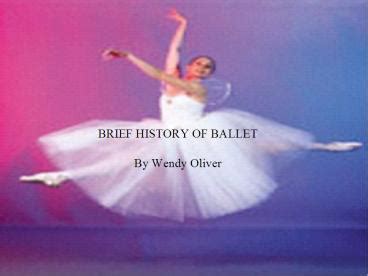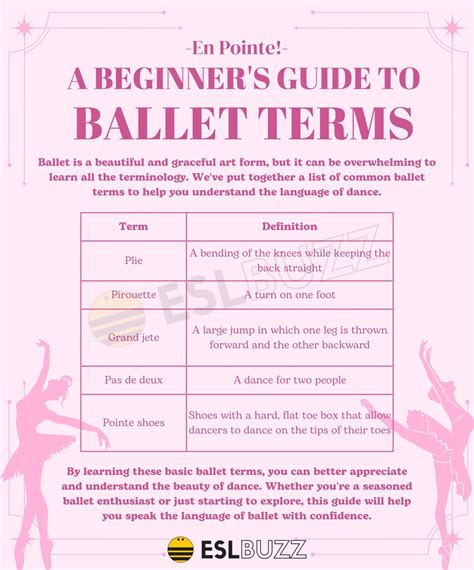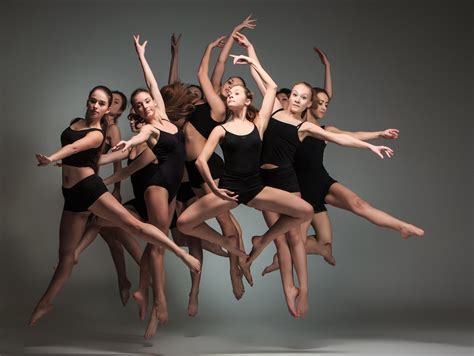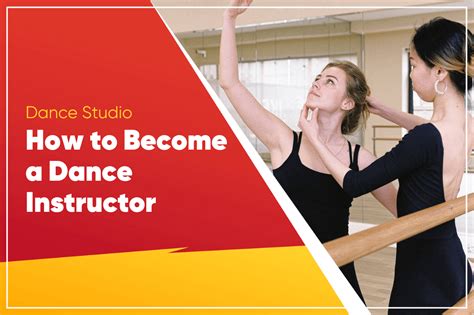Embarking on a whimsical journey of expression and rhythm, one can find themselves captivated by the awe-inspiring realm of the human body in motion. Unveiling a universe entwined with grace and passion, dancers transport us to a realm where words cease to exist, and emotions are communicated through the language of movement. In this enchanted landscape, ballet and contemporary dance take center stage, enchanting spectators with their elegance and candor.
Within the realm of dance, ballet reigns as an iconic cornerstone, harking back to centuries of tradition and exuding a timeless allure. As dancers clad in ethereal costumes glide effortlessly across the stage, the air becomes charged with an ambiance that transcends space and time. Weaving intricate patterns and defying gravity's limitations, ballet dancers possess a unique ability to tell stories without uttering a single word, stirring emotions deep within our souls.
While ballet embraces classical beauty and poise, contemporary dance emerges as a rebel, challenging conventions and molding movement into new and unexpected forms. A realm of boundless creativity, contemporary dance embodies a fusion of styles and explores the depths of human experience. Through fluid movements and innovative choreography, contemporary dancers delve into the realms of ambiguity and vulnerability, leaving our hearts pounding and our minds reeling from the sheer intensity of their performances.
Diving into the Enchanting World of Ballet: A Brief Historical and Overview

Embark on a mesmerizing journey into the captivating realm of ballet, where grace, beauty, and passion converge to bring timeless artistry and storytelling to life. Delve deep into the rich history and evolution of this classical dance form that has enthralled audiences for centuries.
Ancient Origins:
Through the corridors of time, traces of ballet-like movements can be found in the rituals and ceremonies of civilizations long past. However, it was during the Italian Renaissance that the foundations of ballet as we know it began to take shape. Emerging from court dances, ballet gradually evolved into a distinct form of self-expression and artistic storytelling.
The Birth of Ballet:
In the 17th century, France became the birthplace of professional ballet. With the establishment of the Académie Royale de Danse in 1661, King Louis XIV played a pivotal role in transforming ballet into a structured art form with defined techniques and training methods. His love for dance and his contributions to its development earned him the title "The Sun King" and solidified ballet's significance in French culture.
The Classical Era:
During the 19th century, ballet underwent a period of unparalleled growth and innovation, known as the Classical Era. Legendary choreographers such as Marius Petipa revolutionized the art form by creating iconic works like "Swan Lake," "The Nutcracker," and "Sleeping Beauty," which continue to captivate audiences worldwide to this day. The Classical Era also witnessed advancements in costumes, stage design, and pointe technique, elevating ballet to new heights of technical excellence.
20th Century and Beyond:
The 20th century marked a significant turning point in the history of ballet. Ballet companies emerged as prominent institutions, and visionary choreographers like George Balanchine and Rudolf Nureyev pushed the boundaries of traditional ballet, infusing it with elements of modernity and individual expression. This era also saw the emergence of neoclassical ballet and contemporary ballet, reflecting the changing sensibilities and artistic preferences of the time.
Today and the Future:
Ballet continues to evolve and adapt to the ever-changing world, with choreographers exploring new narratives, techniques, and styles. Dancers train rigorously to mold their bodies into instruments of grace, mastering intricate steps, leaps, and turns. The devotion and dedication required to excel in ballet are surpassed only by the sheer joy and fulfillment that comes from expressing oneself through this timeless art form.
Immerse yourself in the mesmerizing world of ballet, where each movement tells a story, and grace becomes poetry in motion. Explore the stages, the costumes, and the iconic works that have shaped the history of this exquisite art form. Let the elegance of ballet transport you to a realm where dreams come alive.
Exploring the Origins and Evolution of Ballet: Unveiling Centuries of Dance
Delve into the captivating journey of ballet, as we embark on an exploration of its historical roots and trace its remarkable evolution throughout the centuries. From its early origins to its modern-day adaptations, this section uncovers the mesmerizing tale of this elegant art form.
Embarking on a historical quest, we'll uncover the mysterious origins of ballet, tracing its roots back to the Renaissance era where court spectacles and elegant social dances laid the groundwork for what would eventually become ballet. We'll delve into the transformation of ballet during the Baroque period, as iconic ballet masters shaped the art form and established the foundations of classical ballet technique.
As the centuries progressed, ballet underwent significant changes, weaving through different cultural influences and artistic trends. From the opulent courts of France to the imperial Russian ballet, we'll explore the rich diversity of ballet styles that emerged along the way, each contributing its distinct flair and flair.
Not only did ballet adapt stylistically, but it also expanded its repertoire, incorporating new movements, techniques, and themes. We'll uncover how ballet evolved from a predominantly courtly entertainment to a theatrical spectacle, gaining popularity among both aristocracy and the general public.
Throughout this section, we'll also illuminate the profound impact of key figures in ballet's history, from influential choreographers and dancers to groundbreaking composers and designers. Their contributions propelled ballet forward, pushing boundaries and challenging conventions, paving the way for the exciting blend of tradition and innovation that characterizes contemporary ballet.
Join us on this captivating journey through time, as we unravel the fascinating origins and ever-evolving nature of ballet. Gain a deeper appreciation for this ethereal art form that continues to enchant audiences worldwide.
The Art of Ballet: Exploring the Techniques and Vocabulary

In this section, we will delve into the captivating world of ballet, exploring its intricate techniques and familiarizing ourselves with the terminology that makes this art form unique.
Ballet is a highly disciplined and demanding form of dance that requires precision, strength, and grace. Its techniques have evolved over centuries, providing dancers with a comprehensive system of movement and expression. Understanding the foundations of ballet technique is essential for dancers to master the art and communicate their stories on stage.
| Technique | Description |
|---|---|
| Turnout | The rotation of the legs from the hips, enabling the dancer to perform movements with a fully rotated position. |
| Plie | A bending of the knees while maintaining an upright posture, serving as the basis for many ballet movements. |
| Pointe Work | The technique of dancing on the tips of the toes while wearing specialized shoes, requiring strength, balance, and proper alignment. |
| Port de Bras | The movement and positioning of the arms, which adds beauty and fluidity to ballet dance sequences. |
| Adagio | A slow and lyrical part of a ballet routine that focuses on sustained movement and graceful transitions. |
| Pirouette | A challenging spinning movement performed on one leg, commonly seen in classical ballet variations. |
Mastering these techniques requires years of dedicated practice, as each movement demands control, balance, and a deep understanding of body placement. As we unravel the secrets behind these techniques and expand our vocabulary, we gain insight into the expressive power of ballet and the dedication required to excel in this art form.
Exploring the Essence of Ballet: Understanding the Core Movements and Terminology
In this section, we embark on a journey to delve into the foundation of ballet and its essence through the exploration of fundamental movements and the rich vocabulary utilized within this timeless art form. By grasping the essence of ballet's core movements and vocabulary, we gain a deeper understanding of the artistry and grace that is synonymous with ballet.
To truly appreciate ballet, it is essential to comprehend the intricacies of its core movements. These movements are the building blocks that form the foundation of every ballet performance. From the graceful arabesque to the powerful pirouette, each movement showcases the immense skill and control required to execute ballet techniques with precision and elegance.
Embracing the beauty and precision of ballet also requires an understanding of its unique vocabulary. Ballet terminology consists of a rich collection of French words that have been adopted and standardized across the global ballet community. From the various positions of the feet such as first position (premier position) to the complex and mesmerizing sequences known as adagio and allegro, this vocabulary brings an added layer of grace and sophistication to the art of ballet.
| Term | Definition |
|---|---|
| Plie | A bending of the knees while maintaining the alignment of the body. |
| Tendu | A movement in which the foot stretches along the floor, pointing to the front, side, or back. |
| Grand jeté | A large leap, taking off from one leg and landing on the other. |
| Pas de deux | A dance for two, typically consisting of a male and a female dancer. |
As we embark on this exploration, we will uncover the depth and beauty behind each movement and terminology, gaining a profound appreciation for the artistry and dedication required to master the enchanting world of ballet.
Exploring the Fusion of Styles and Expressions in Modern Dance

In this section, we delve into the captivating world of contemporary dance, where a myriad of styles and expressions converge to create a unique form of artistic expression. Contemporary dance is a dynamic and eclectic mix of movement, drawing inspiration from various genres such as jazz, hip-hop, ballet, and many more.
Unleashing Creativity: Contemporary dance offers dancers the freedom to experiment and push boundaries, allowing them to break away from traditional norms and explore new forms of movement. Through a fusion of styles, dancers are able to convey their emotions, ideas, and stories in a fluid and innovative manner.
Expressing Individuality: One of the defining characteristics of contemporary dance is its emphasis on individuality. Dancers are encouraged to infuse their unique personalities and experiences into their performances, using their bodies as a powerful tool for self-expression. This allows for a deeply personal and authentic connection between the dancer and the audience.
Fluidity and Versatility: Unlike the structured and precise movements of ballet, contemporary dance embraces fluidity and versatility. Dancers explore a wide range of movements, from graceful and flowing to sharp and dynamic, seamlessly transitioning between different styles and tempos. This versatility adds layers of complexity and intrigue to their performances.
Musicality and Interpretation: Contemporary dance places a strong emphasis on musicality and interpretation. Dancers use their bodies to interpret the nuances of the music, bringing it to life through their movements. They create a dialogue between their bodies and the music, using rhythm, tempo, and dynamics to intensify their connection with the audience.
Captivating Choreography: The choreography in contemporary dance is a reflection of the diverse influences and artistic visions of the choreographers. Each piece is carefully crafted to evoke emotions, challenge perceptions, and ignite the imagination. From abstract and thought-provoking to narrative-driven, the choreography captivates the audience and invites them on a visual and emotional journey.
In conclusion, contemporary dance is a harmonious fusion of various styles and expressions, giving rise to a captivating form of artistic communication. Through its emphasis on individuality, fluidity, musicality, and captivating choreography, contemporary dance continues to push boundaries, challenge norms, and inspire both dancers and audiences alike.
Unveiling the Varied Influences and Distinct Characteristics of Modern Dance
In this section, we will delve into the multifaceted influences and unique qualities that define the realm of contemporary dance. Through an exploration of diverse cultural, artistic, and historical inspirations, we aim to shed light on the dynamic nature of this expressive form. By uncovering the intricate interplay between movement, emotion, and innovation, we will gain a deeper understanding of the captivating world of modern dance.
Contemporary dance draws from a multitude of sources, encompassing a wide range of genres and styles to create a truly distinctive art form. As artists push boundaries and challenge traditional notions of movement, they incorporate elements from various disciplines such as classical ballet, jazz, African dance, and martial arts. By seamlessly blending these influences, contemporary dance showcases a fusion of techniques that is both fluid and unpredictable.
One of the defining characteristics of contemporary dance is its emphasis on individualism and creative interpretation. Dancers are encouraged to develop their own unique style and express their personal narratives through movement. This freedom allows for endless possibilities in choreography and fosters a sense of authenticity and spontaneity on stage. | Moreover, contemporary dance often serves as a form of social commentary, addressing pertinent issues of our time. Through symbolic gestures and thought-provoking movements, artists strive to challenge conventions, evoke emotions, and provoke introspection among audiences. By intertwining powerful storytelling with physical prowess, contemporary dance becomes a medium for societal reflection and cultural critique. |
Additionally, contemporary dance embraces the exploration of space, enabling performers to interact with their surroundings in innovative ways. Dancers defy gravity, manipulate their bodies, and experiment with unconventional movement patterns that defy traditional norms. This focus on spatial dynamics not only pushes the boundaries of physicality but also adds depth and dimension to the overall visual composition of the performance.
By delving into the diverse influences and unique characteristics of contemporary dance, we gain a greater appreciation for the complexity and beauty of this ever-evolving art form. Its ability to transcend boundaries and challenge conventions makes it an unparalleled medium of self-expression and storytelling. Whether through powerful leaps, graceful extensions, or subtle gestures, contemporary dance captivates, inspires, and leaves an indelible mark on all who witness its magic.
The Journey to Becoming a Dancer: Training and Challenges

Embarking on the path to become a professional dancer requires dedication, perseverance, and a deep passion for the art form. This section delves into the rigorous training process and the various challenges aspiring dancers encounter along the way.
Foundation and Technique: Developing a strong foundation is crucial for any dancer. Beginning with basic movements and gradually progressing to more complex techniques, dancers undergo rigorous training to master the fundamentals. This includes honing coordination, balance, strength, and flexibility through consistent practice and discipline.
Physical Demands: Ballet and contemporary dance demand immense physical endurance and strength. Dancers must cultivate long, lean muscles while maintaining their agility and grace. They often face physical challenges such as fatigue, injury, and muscle soreness. It requires immense dedication and resilience to push through these challenges and continue to improve.
Artistic Expression: Beyond the technical aspects, dancers strive to convey emotion and tell stories through their movements. They explore different styles and genres, discovering their unique artistic voice. Developing an authentic expression requires vulnerability and the ability to tap into one's emotions and connect with the audience.
Competition and Auditions: The path to becoming a professional dancer is highly competitive. Dancers often face numerous auditions, vying for limited spots in prestigious dance companies or schools. They must showcase not only their technical skills but also their individuality, stage presence, and ability to adapt to different choreographic styles. Rejection is a common aspect of the journey, and resilience is essential to persevere and learn from each experience.
Mental and Emotional Challenges: The journey to becoming a dancer is not just physical but also mental and emotional. Dancers face self-doubt, criticism, and intense pressure to meet expectations. They grapple with maintaining a healthy mindset, building resilience, and staying motivated despite setbacks. Self-care, support systems, and finding balance in life become crucial elements of navigating these challenges.
Continual Learning and Growth: As with any art form, dance is a lifelong learning process. Even established dancers continue to refine their skills and explore new avenues of creativity. Embracing continuous growth and adopting a growth mindset are essential for dancers to thrive in an ever-evolving industry.
In conclusion, the journey to become a professional dancer is filled with training, challenges, and personal growth. It demands unwavering dedication, a commitment to improving technique, and the ability to overcome physical, artistic, and mental obstacles. By embracing the process and remaining resilient, aspiring dancers can pave their way towards a fulfilling career in the world of dance.
FAQ
What are the secrets of ballet and contemporary dance?
The secrets of ballet and contemporary dance lie in the years of training, dedication, and passion that dancers put into perfecting their craft. These dance styles require immense strength, flexibility, and coordination. Ballet focuses on precise technique and graceful movements, while contemporary dance allows for more freedom of expression and experimentation. Both forms require discipline, hard work, and a deep understanding of music and rhythm.
How long does it take to become a professional ballet dancer?
Becoming a professional ballet dancer takes years of rigorous training and practice. Generally, aspiring dancers begin their training at a very young age, around 5-8 years old. They attend regular ballet classes, often several times a week, to develop their technique, strength, and flexibility. This training continues throughout their teenage years and into adulthood. It usually takes a minimum of 8-10 years of consistent training to become a professional ballet dancer, although this can vary depending on the individual's talent and dedication.
What are the benefits of ballet and contemporary dance?
Ballet and contemporary dance offer numerous physical, mental, and emotional benefits. Physically, these dance forms improve strength, flexibility, and posture. They also help develop endurance, coordination, and body awareness. Dancing can be a great cardio workout, promoting weight loss and overall fitness. Mentally, ballet and contemporary dance enhance focus, concentration, and memory. They also provide an outlet for self-expression and creativity, boosting confidence and self-esteem. Emotionally, these dance forms can be a cathartic and therapeutic form of expression, relieving stress and improving overall well-being.



